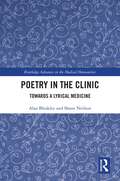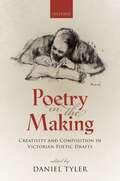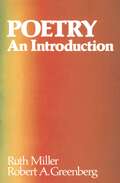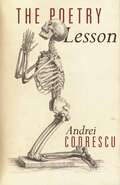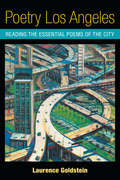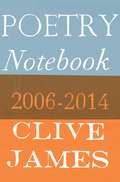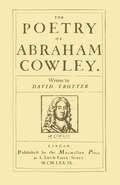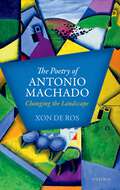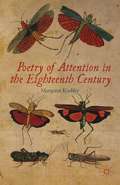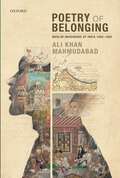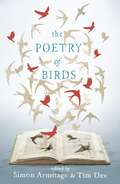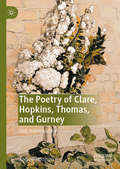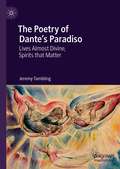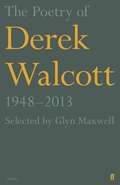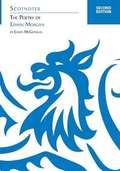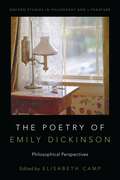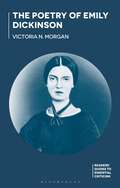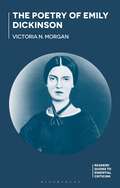- Table View
- List View
Poetry in the Clinic: Towards a Lyrical Medicine (Routledge Advances in the Medical Humanities)
by Alan Bleakley Shane NeilsonThis book explores previously unexamined overlaps between the poetic imagination and the medical mind. It shows how appreciation of poetry can help us to engage with medicine in more intense ways based on ‘defamiliarising’ old habits and bringing poetic forms of ‘close reading’ to the clinic. Bleakley and Neilson carry out an extensive critical examination of the well-established practices of narrative medicine to show that non-narrative, lyrical poetry does different kind of work, previously unexamined, such as place eclipsing time. They articulate a groundbreaking ‘lyrical medicine’ that promotes aesthetic, ethical and political practices as well as noting the often-concealed metaphor cache of biomedicine. Demonstrating that ambiguity is a key resource in both poetry and medicine, the authors anatomise poetic and medical practices as forms of extended and situated cognition, grounded in close readings of singular contexts. They illustrate structural correspondences between poetic diction and clinical thinking, such as use of sound and metaphor. This provocative examination of the meaningful overlap between poetic and clinical work is an essential read for researchers and practitioners interested in extending the reach of medical and health humanities, narrative medicine, medical education and English literature.
Poetry in the Clinic: Towards a Lyrical Medicine (Routledge Advances in the Medical Humanities)
by Alan Bleakley Shane NeilsonThis book explores previously unexamined overlaps between the poetic imagination and the medical mind. It shows how appreciation of poetry can help us to engage with medicine in more intense ways based on ‘defamiliarising’ old habits and bringing poetic forms of ‘close reading’ to the clinic. Bleakley and Neilson carry out an extensive critical examination of the well-established practices of narrative medicine to show that non-narrative, lyrical poetry does different kind of work, previously unexamined, such as place eclipsing time. They articulate a groundbreaking ‘lyrical medicine’ that promotes aesthetic, ethical and political practices as well as noting the often-concealed metaphor cache of biomedicine. Demonstrating that ambiguity is a key resource in both poetry and medicine, the authors anatomise poetic and medical practices as forms of extended and situated cognition, grounded in close readings of singular contexts. They illustrate structural correspondences between poetic diction and clinical thinking, such as use of sound and metaphor. This provocative examination of the meaningful overlap between poetic and clinical work is an essential read for researchers and practitioners interested in extending the reach of medical and health humanities, narrative medicine, medical education and English literature.
Poetry in the Making: Creativity and Composition in Victorian Poetic Drafts
by Daniel TylerPoetry in the Making investigates the compositional practices of Victorian poets, as made evident in the autograph manuscripts of their poems. Written in an accessible and stimulating style, the book offers careful readings of individual drafts, paying attention to the revisions, cancellations, interlineations, trials of rhyme and form, and sometimes the large structural changes that these documents reveal. The book shows how manuscript revisions offer insights into the creative priorities and decisions of major Victorian poets (Wordsworth, Tennyson, the Brownings, Clough, Hopkins, Christina Rossetti, Swinburne, and Yeats); and they investigate ideas of composition in the period, particularly the uneasy balance between inspiration and labour. The book testifies to the care that poets exercised at the smallest levels of their craft and demonstrates that the drafts reward an equally close attention on the part of the critic. Collectively, the chapters develop a survey of how Victorian poets experienced and understood their own creativity, setting abstract claims about inspiration and craftsmanship against their own practical experiences. The book responds to and extends a renewed interest in manuscript sources at the present time that has been stimulated in part by the increased availability of digital and facsimile editions. For a long time, scholarly interest in nineteenth-century literary manuscripts has been dominated by editorial and theoretical concerns. This book testifies to the value for criticism of poetic drafts, establishing the significance of revision and of manuscript studies for the field of Victorian poetry and for literary scholarship more generally.
Poetry in the Making: Creativity and Composition in Victorian Poetic Drafts
Poetry in the Making investigates the compositional practices of Victorian poets, as made evident in the autograph manuscripts of their poems. Written in an accessible and stimulating style, the book offers careful readings of individual drafts, paying attention to the revisions, cancellations, interlineations, trials of rhyme and form, and sometimes the large structural changes that these documents reveal. The book shows how manuscript revisions offer insights into the creative priorities and decisions of major Victorian poets (Wordsworth, Tennyson, the Brownings, Clough, Hopkins, Christina Rossetti, Swinburne, and Yeats); and they investigate ideas of composition in the period, particularly the uneasy balance between inspiration and labour. The book testifies to the care that poets exercised at the smallest levels of their craft and demonstrates that the drafts reward an equally close attention on the part of the critic. Collectively, the chapters develop a survey of how Victorian poets experienced and understood their own creativity, setting abstract claims about inspiration and craftsmanship against their own practical experiences. The book responds to and extends a renewed interest in manuscript sources at the present time that has been stimulated in part by the increased availability of digital and facsimile editions. For a long time, scholarly interest in nineteenth-century literary manuscripts has been dominated by editorial and theoretical concerns. This book testifies to the value for criticism of poetic drafts, establishing the significance of revision and of manuscript studies for the field of Victorian poetry and for literary scholarship more generally.
Poetry: An Introduction
by Ruth Miller and Robert A. GreenbergThis book provides an introduction to the elements of poetry, formulates a series of contexts for the interpretation of poems, and offers a substantial anthology. Its purpose is to enable students to read poems with understanding and pleasure and to provide them with a basic vocabulary for analysing and talking about poems.
Poetry & Language Writing: Objective and Surreal (Poetry &... #2)
by David ArnoldIt has been variously labelled ‘Language Poetry’, ‘Language Writing’, ‘L=A=N=G=U=A=G=E writing’ (after the magazine that ran from 1978 to 1981), and ‘language-centred writing’. It has been placed according to its geographical positions, on East or West coasts; its venues in small magazines, independent presses and performance spaces, and its descent from historical precursors, be they the Objectivists, the composers-by-field of the Black Mountain School, the Russian Constructivists or American modernism à la William Carlos Williams and Gertrude Stein. Indeed, one of the few statements that can be made about it with little qualification is that ‘it’ has both fostered and endured a crisis in representation more or less since it first became visible in the 1970s. In Poetry & Language Writing David Arnold grasps the nettle of Language poetry, reassessing its relationship with surrealism and providing a scholarly, intelligent way of understanding the movement. Poets discussed include Charles Bernstein, Susan Howe, Michael Palmer and Barrett Watten.
The Poetry Lesson
by Andrei Codrescu"Intro to Poetry Writing is always like this: a long labor, a breech birth, or, obversely, mining in the dark. You take healthy young Americans used to sunshine (aided sometimes by Xanax and Adderall), you blindfold them and lead them by the hand into a labyrinth made from bones. Then you tell them their assignment: 'Find the Grail. You have a New York minute to get it.'"--The Poetry Lesson ? The Poetry Lesson is a hilarious account of the first day of a creative writing course taught by a "typical fin-de-siècle salaried beatnik"--one with an antic imagination, an outsized personality and libido, and an endless store of entertaining literary anecdotes, reliable or otherwise. Neither a novel nor a memoir but mimicking aspects of each, The Poetry Lesson is pure Andrei Codrescu: irreverent, unconventional, brilliant, and always funny. Codrescu takes readers into the strange classroom and even stranger mind of a poet and English professor on the eve of retirement as he begins to teach his final semester of Intro to Poetry Writing. As he introduces his students to THE TOOLS OF POETRY (a list that includes a goatskin dream notebook, hypnosis, and cable TV) and THE TEN MUSES OF POETRY (mishearing, misunderstanding, mistranslating . . . ), and assigns each of them a tutelary "Ghost-Companion" poet, the teacher recalls wild tales from his coming of age as a poet in the 1960s and 1970s, even as he speculates about the lives and poetic and sexual potential of his twenty-first-century students. From arguing that Allen Ginsberg wasn't actually gay to telling about the time William Burroughs's funeral procession stopped at McDonald's, The Poetry Lesson is a thoroughly entertaining portrait of an inimitable poet, teacher, and storyteller.
The Poetry Lesson
by Andrei Codrescu"Intro to Poetry Writing is always like this: a long labor, a breech birth, or, obversely, mining in the dark. You take healthy young Americans used to sunshine (aided sometimes by Xanax and Adderall), you blindfold them and lead them by the hand into a labyrinth made from bones. Then you tell them their assignment: 'Find the Grail. You have a New York minute to get it.'"--The Poetry Lesson ? The Poetry Lesson is a hilarious account of the first day of a creative writing course taught by a "typical fin-de-siècle salaried beatnik"--one with an antic imagination, an outsized personality and libido, and an endless store of entertaining literary anecdotes, reliable or otherwise. Neither a novel nor a memoir but mimicking aspects of each, The Poetry Lesson is pure Andrei Codrescu: irreverent, unconventional, brilliant, and always funny. Codrescu takes readers into the strange classroom and even stranger mind of a poet and English professor on the eve of retirement as he begins to teach his final semester of Intro to Poetry Writing. As he introduces his students to THE TOOLS OF POETRY (a list that includes a goatskin dream notebook, hypnosis, and cable TV) and THE TEN MUSES OF POETRY (mishearing, misunderstanding, mistranslating . . . ), and assigns each of them a tutelary "Ghost-Companion" poet, the teacher recalls wild tales from his coming of age as a poet in the 1960s and 1970s, even as he speculates about the lives and poetic and sexual potential of his twenty-first-century students. From arguing that Allen Ginsberg wasn't actually gay to telling about the time William Burroughs's funeral procession stopped at McDonald's, The Poetry Lesson is a thoroughly entertaining portrait of an inimitable poet, teacher, and storyteller.
Poetry & Listening: The Noise of Lyric (Poetry &... #10)
by Zoë SkouldingListening has always mattered in poetry, but how does poetry change when listening has been transformed? In Poetry & Listening: The Noise of Lyric, the field of sound studies, which has revolutionised research in contemporary music, is brought into dialogue with new lyric criticism. Examining poetry as mediated by performance, technology and translation, this book discovers how contemporary poetry has been re-energised by the influence of recorded sound and influenced by the creative methods that emerged with it. It offers an exploration of contemporary poetry’s acoustic contexts, moving beyond traditional analysis of poetic form to consider the social, political and ecological dimensions of a poem's sounds and silences. Through lucid engagement with a range of richly innovative English-language poetry from the UK and USA, it argues for the centrality of listening to a form of composition in which language not only represents sonic experience but is part of it. With reference to Jean-Luc Nancy’s distinction between hearing and listening, alongside other key theorists of sound and noise, it shows how poetry offers insights into sensory perception, and how it charts acoustic relationships between language and the environment.
Poetry Los Angeles: Reading the Essential Poems of the City
by Laurence GoldsteinIs there such a thing as Los Angeles poetry? How do we assess a poem about a city as elusive of identity as Los Angeles? What features do poems about this unique urban landscape of diverse peoples and terrains have in common? Poetry Los Angeles is the first book to gather and analyze poems about sites as different as Hollywood, Santa Monica and Venice beaches, the freeways, downtown, South Central and East L.A. Laurence Goldstein presents original commentary on six decades of poets who have contributed to the iconography and poetics of Los Angeles literature, including Elizabeth Alexander, Jimmy Santiago Baca, Dorothy Barresi, Victoria Chang, Wanda Coleman, Dana Gioia, Joy Harjo, James Harms, Robert Hass, Eloise Klein Healy, Garrett Hongo, Suzanne Lummis, Paul Monette, Harryette Mullen, Carol Muske-Dukes, Frederick Seidel, Gary Soto, Timothy Steele, Diane Wakoski, Derek Walcott, and Charles Harper Webb. Forty poems are reproduced in their entirety. One chapter is devoted to Charles Bukowski, the celebrity face of the city’s poetry. Other chapters discuss the ways that poets explore “Interiors” and “Exteriors” throughout the cityscape. Goldstein also provides ample connections to the novels, films, art, and politics of Southern California. In clear prose, Poetry Los Angeles examines the strategies by which poets make significant places meaningful and memorable to readers of every region of the U.S. and elsewhere.
Poetry & Money: A Speculation (Poetry &... #11)
by Peter RobinsonPoetry & Money: A Speculation is a study of relationships between poets, poetry, and money from Chaucer to contemporary times. It begins by showing how trust is essential to the creation of value in human exchange, and how money can, depending on conditions, both enable and disable such trustfully collaborative generations of value. Drawing upon a vast range of poetry for its exemplifications, the book includes studies of poetic hardship, religious verse and debt redeeming, the South Sea Bubble and the economic revolution, debates over metallic and paper currency in the eighteenth and nineteenth centuries, as well as modernist struggles with the gold standard, depression, inflation, and the realised groundlessness of exchange value. With its practitioner’s attention to the minutiae of poetic technique, it considers analogies between words and coins, and between poetic rhythm and the circulation of currencies in an economy. Through its close readings of poems over many centuries directly or indirectly engaged with money, it proposes ways in which, while we cannot escape monetary economies, we can resist, to some extent, being ensnared and diminished by them – through a fresh understanding of values money may serve to enable, but ones which are nevertheless beyond price.
Poetry Notebook: 2006–2014
by Clive JamesClive James is one of our finest critics and best-loved cultural voices. He is also a prize-winning poet. Since he was first enthralled by the mysterious power of poetry, he has been a dedicated student. In fact, for him, poetry has been nothing less than the occupation of a lifetime, and in this book he presents a distillation of all he's learned about the art form that matters to him most.With his customary wit, delightfully lucid prose style and wide-ranging knowledge, James explains the difference between the innocuous stuff that often passes for poetry today and a real poem: the latter being a work of unity that insists on being heard entire and threatens never to leave the memory. A committed formalist and an astute commentator, he offers close and careful readings of individual poems and poets (from Shakespeare to Larkin, Keats to Pound), and in some case second readings or re-readings late in life - just to be sure he wasn't wrong the first time! Whether discussing technical details of metaphorical creativity or simply praising his five favourite collections of all time, he is never less than captivating.
The Poetry of Antonio Machado: Changing the Landscape
by Xon De RosThis study offers a reappraisal of the contribution of the poet Antonio Machado to Modernism, seeking to open up new perspectives for the interpretation of his poetry, and includes for the first time a comparative analysis of Machado's translators into English. While the book is attentive to areas of recent critical debate, the argument keeps Machado's poems to the fore, with new detailed readings of many of his most significant poems. The reader will find that the structure of this book also allows for a separate exploration of each of Machado's main poetic tendencies. One associated with the Symbolist poetics is considered in Chapter I dealing with those early poems where the sound of water acquires a rich symbolic meaning. An emphasis on the visual imagination is more prevalent in the material studied in chapters II and III with a focus on the natural landscape, while the more conceptual and intellectual strand occupies Chapter IV. Every individual chapter begins with a brief introduction to the theoretical ground related to the specific discussion (on gender, space-place, the sublime, and translation, respectively), and a survey of the cultural discourses which situate the material under analysis in the original historical contexts.
Poetry of Attention in the Eighteenth Century
by M. KoehlerBy identifying a pervasive cultivation of attention as a perceptual and cognitive state in eighteenth-century poetry, this book explores overt themes of attention and demonstrate techniques of readerly attention.
Poetry of Belonging: Muslim Imaginings of India 1850–1950
by Ali Khan MahmudabadPoetry of Belonging is an exploration of north-Indian Muslim identity through poetry at a time when the Indian nation state did not exist. Between 1850 and 1950, when precolonial forms of cultural traditions, such as the musha’irah, were undergoing massive transformations to remain relevant, certain Muslim ‘voices’ configured, negotiated, and articulated their imaginings of what it meant to be Muslim. Using poetry as an archive, the book traces the history of the musha’irah, the site of poetic performance, as a way of understanding public spaces through the changing economic, social, political, and technological contexts of the time. It seeks to locate the changing ideas of watan (homeland) and hubb-e watanī (patriotism) in order to offer new perspectives on how Muslim intellectuals, poets, political leaders, and journalists conceived of and expressed their relationship to India and to the transnational Muslim community. The volume aims to spark a renegotiation of identity and belonging, especially at a time when Muslim loyalty to India has yet again emerged as a politically polarizing question.
The Poetry of Birds
by Simon ArmitageBirds are the most obvious wild things we have around us. They are much watched and much loved, not least by poets.Bird poetry is as old as British poetry itself, and a remarkable number of poets have written poems about birds. Indeed some of the most famous poems in the language concern birds, from Keats's nightingale and Shelley's skylark to Yeats's swans and Hardy's thrush.In this wonderful anthology poet Simon Armitage and birdwatching enthusiast Tim Dee gather together the best of the past and the present, including those famous poems but also many overlooked gems. And in a fascinating divergence from standard anthology practice, the poems are organized according to ornithological classification, beginning with poems by Marianne Moore and David Wright on the ostrich and the emperor penguin and ending with Emily Dickinson and Wallace Stevens on the oriole and the blackbird.
The Poetry of Clare, Hopkins, Thomas, and Gurney: Lyric Individualism
by Andrew HodgsonThis book attends to four poets – John Clare, Gerard Manley Hopkins, Edward Thomas, and Ivor Gurney – whose poems are remarkable for their personal directness and distinctiveness. It shows how their writing conveys a potently individual quality of feeling, perception, and experience: each poet responds with unusual commitment to the Romantic idea of art as personal expression. The book looks closely at the vitality and intricacy of the poets’ language, the personal candour of their subject matter, and their sense, obdurate but persuasive, of their own strangeness. As it traces the tact and imagination with which each of the four writers realises the possibilities of individualism in lyric, it affirms the vibrancy of their contributions to nineteenth and twentieth-century poetry.
The Poetry of Dante's Paradiso: Lives Almost Divine, Spirits that Matter
by Jeremy TamblingThis book argues that Paradiso – Dante’s vision of Heaven – is not simply affirmative. It posits that Paradiso compensates for disappointment rather than fulfils hopes, and where it moves into joy and vision, this also rationalises the experience of exile and the failure of all Dante’s political hopes. The book highlights and addresses a fundamental problem in reading Dante: the assumption that he writes as a Catholic Christian, which can be off-putting and induces an overly theological and partisan reading in some commentary. Accordingly, the study argues that Dante must be read now in a post-Christian modernity. It discusses Dante's Christianity fully, and takes its details as a source of wonder and beauty which need communicating to a modern reader. Yet, the study also argues that we must read for the alterity of Dante’s world from ours.
The Poetry of Derek Walcott 1948–2013
by Derek Walcott'He gives us more than himself or 'a world'; he gives us a sense of infinity embodied in the language.' Alongside Joseph Brodsky's words of praise one might mention the more concrete honours that the renowned poet Derek Walcott has received: a MacArthur Fellowship; the Queen's Gold Medal for Poetry; the Nobel Prize in Literature. The Poetry of Derek Walcott 1948-2013 draws from every stage of the poet's storied career. Here are examples of his very earliest work, like 'In My Eighteenth Year,' published when the poet himself was still a teenager; his first widely celebrated verse, like 'A Far Cry from Africa,' which speaks of violence, of loyalties divided in one's very blood; his mature work, like 'The Schooner Flight' from The Star-Apple Kingdom; and his late masterpieces, like the tender 'Sixty Years After,' from the 2010 collection White Egrets. Across sixty-five years, Walcott has grappled with the themes that have defined his work as they have defined his life: the unsolvable riddle of identity; the painful legacy of colonialism on his native Caribbean island of St. Lucia; the mysteries of faith and love and the natural world; the Western canon, celebrated and problematic; the trauma of growing old, of losing friends, family, one's own memory. This collection, selected by Walcott's friend the English poet Glyn Maxwell, will prove as enduring as the questions, the passions, that have driven Walcott to write for more than half a century.
The Poetry of Dylan Thomas: Under the Spelling Wall (Liverpool English Texts and Studies #60)
by John GoodbyPublished in anticipation of the centenary of the poet’s birth, The Poetry of Dylan Thomas is the first study of the poet to show how his work may be read in terms of contemporary critical concerns, using theories of modernism, the body, gender, the carnivalesque, language, hybridity and the pastoral in order to view it in an original light. Moreover, in presenting a Dylan Thomas who has real significance for twenty-first century readers, it shows that such a reappraisal also requires us to re-think some of the ways in which all post-Waste Land British poetry has been read in the last few decades.
The Poetry Of Edwin Morgan (Scotnotes Study Guides #2)
by James McGonigalEdwin Morgan (1920–2010) is one of the giants of modern poetry. Scotland’s national poet from 2004 to his death in 2010, he produced an astonishing range of work, from the playful to the profound. James McGonigal’s Second Edition of this Scotnote (2013) covers the entirety of Morgan’s work throughout the poet’s long and hugely productive life, and is an ideal guide for senior school pupils and students to Morgan’s overflowing creativity.
The Poetry of Emily Dickinson: Philosophical Perspectives (Oxford Studies in Philosophy and Literature)
by Elisabeth CampOne of America's most celebrated poets, Emily Dickinson was virtually unpublished in her lifetime. When a slim volume of her poems emerged on the American scene in 1890, her work created shockwaves that have not subsided yet. Famously precise and sparse, Emily Dickinson's poetry is often described as philosophical, both because her poetry grapples with philosophical topics like death, spirituality, and the darkening operations of the mind, and because she approaches those topics in a characteristically philosophical manner: analyzing and extrapolating from close observation, exploring alternatives, and connecting thoughts into cumulative demonstrations. But unlike Lucretius or Pope, she cannot be accused of producing versified treatises. Many of her poems are unsettling in their lack of conclusion; their disparate insights often stand in conflict; and her logic turns crucially on imagery, juxtaposition, assonance, slant rhyme, and punctuation. The six chapters of this volume collectively argue that Dickinson is an epistemically ambitious poet, who explores fundamental questions by advancing arguments that are designed to convince. Dickinson exemplifies abstract ideas in tangible form and habituates readers into productive trains of thought--she doesn't just make philosophical claims, but demonstrates how poetry can make a distinct contribution to philosophy. All essays in this volume, drawn from both philosophers and literary theorists, serve as a counterpoint to recent critical work, which has emphasized Dickinson's anguished uncertainty, her nonconventional style, and the unsettled status of her manuscripts. On the view that emerges here, knowing is like cleaning, mending, and lacemakingL a form of hard, ongoing work, but one for which poetry is a powerful, perhaps indispensable, tool.
The Poetry of Emily Dickinson (Readers' Guides to Essential Criticism)
by Victoria N. MorganTaking readers through the various stages of criticism of Emily Dickinson's poetry, this guide identifies both the essential critical texts and the key debates within them. The texts chosen for discussion represent the canonical readings which have typically shaped the area of Dickinson studies throughout the twentieth- and twenty-first century and provide a lens through which to view current critical trends. Chapters focus on style and meaning, gender and sexuality, history and race, religion and hymn culture, and performance and popular culture. In all, this guide serves as a user-friendly reference tool to the vast body of criticism on Dickinson to date by suggesting formative starting points and underlining essential critical highlights. It provides students and scholars of Dickinson with a sense of where these critical texts can be placed in relation to one another, as well as an understanding of pivotal moments within the history of reception of Dickinson from late nineteenth-century reviews up to some of the definitive critical interventions of the twenty-first century.
The Poetry of Emily Dickinson (Readers' Guides to Essential Criticism)
by Victoria N. MorganTaking readers through the various stages of criticism of Emily Dickinson's poetry, this guide identifies both the essential critical texts and the key debates within them. The texts chosen for discussion represent the canonical readings which have typically shaped the area of Dickinson studies throughout the twentieth- and twenty-first century and provide a lens through which to view current critical trends. Chapters focus on style and meaning, gender and sexuality, history and race, religion and hymn culture, and performance and popular culture. In all, this guide serves as a user-friendly reference tool to the vast body of criticism on Dickinson to date by suggesting formative starting points and underlining essential critical highlights. It provides students and scholars of Dickinson with a sense of where these critical texts can be placed in relation to one another, as well as an understanding of pivotal moments within the history of reception of Dickinson from late nineteenth-century reviews up to some of the definitive critical interventions of the twenty-first century.
